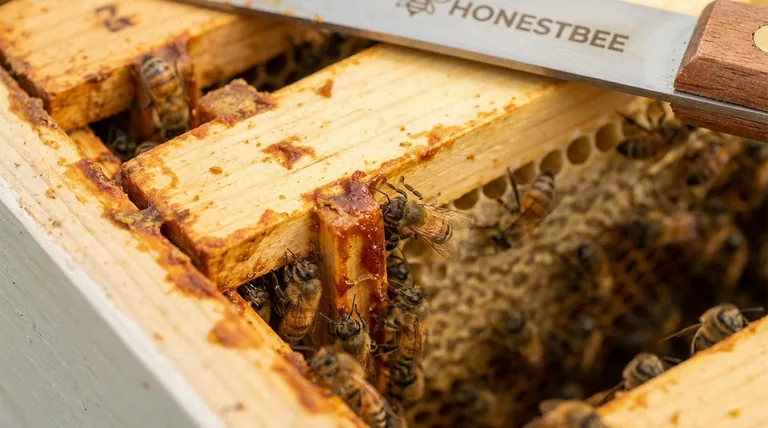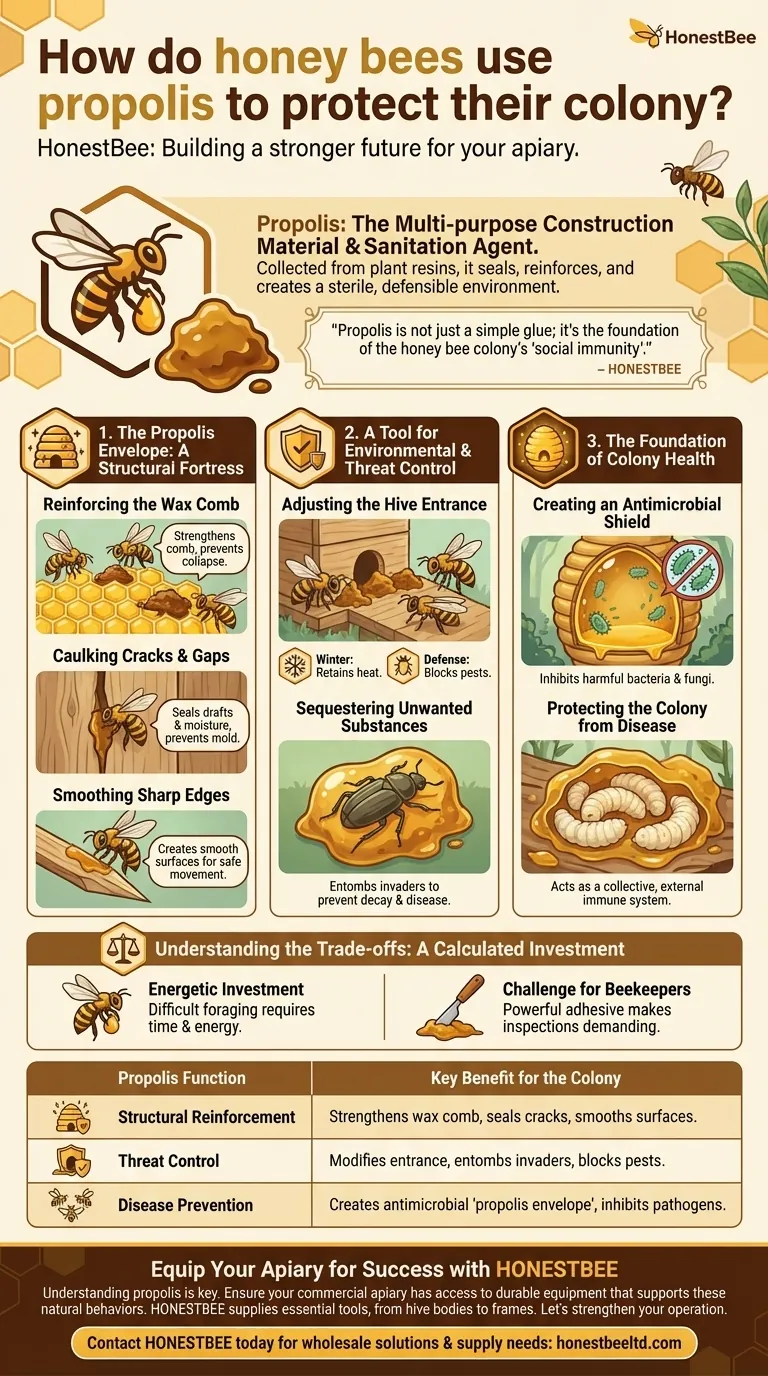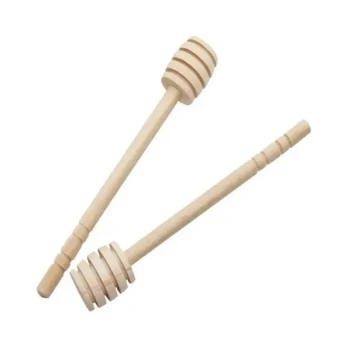In essence, honey bees use propolis as a multi-purpose construction material and sanitation agent. They meticulously collect plant resins to create this sticky, potent substance, using it to seal cracks, reinforce the hive's structure, and create a sterile, defensible environment that is critical for the colony's survival.
Propolis is not just a simple glue; it's the foundation of the honey bee colony's "social immunity." By constructing a propolis envelope, bees create a physically secure and antimicrobial fortress that actively defends against environmental threats and disease.

The Propolis Envelope: A Structural Fortress
A honey bee colony is a dense, bustling city that requires absolute structural integrity. Propolis serves as the bees' primary engineering material to ensure the hive remains stable and safe.
Reinforcing the Wax Comb
Beeswax is a remarkable material, but it can become brittle in the cold or soft in the heat. Bees apply propolis to key structural points of the wax comb, significantly increasing its strength and preventing catastrophic collapses that could destroy brood and food stores.
Caulking Cracks and Gaps
Even the smallest crack can be a major liability. Bees use propolis as a caulk to seal every fissure, preventing drafts that could chill the brood and stopping water intrusion that could lead to mold and moisture damage.
Smoothing Sharp Edges
Inside a hive, which can be a rough tree cavity or a wooden box, sharp edges pose a constant threat to the bees' delicate wings. They carefully coat these hazards with propolis, creating a smooth surface that allows for safe and rapid movement throughout the colony.
A Tool for Environmental and Threat Control
Beyond simple structural repairs, propolis is a dynamic tool used to actively manage the hive's internal environment and neutralize external threats.
Adjusting the Hive Entrance
The hive entrance is a critical vulnerability. Bees use propolis to modify its size, reducing it in winter to conserve heat or narrowing it to create a more defensible chokepoint against robbing insects like wasps.
Sequestering Unwanted Substances
If an invader like a mouse or a large beetle enters the hive and is killed, it may be too large for the bees to remove. To prevent the corpse from decomposing and spreading disease, they entomb it in a "mummy" of propolis, effectively sequestering the threat.
The Foundation of Colony Health
The most vital function of propolis is arguably its role in protecting the colony from microscopic threats. A crowded hive is an ideal breeding ground for pathogens, and propolis is the primary defense.
Creating an Antimicrobial Shield
The resins used to make propolis contain powerful antimicrobial and antifungal compounds. By lining the entire hive cavity with a thin layer of propolis—the "propolis envelope"—the bees create a sterile environment that inhibits the growth of harmful bacteria and fungi.
Protecting the Colony from Disease
This antimicrobial barrier directly shields the colony, especially the vulnerable larvae, from devastating diseases. The constant presence of propolis acts as a form of collective, external immune system for the entire superorganism.
Understanding the Trade-offs
While indispensable, the collection and use of propolis are not without their costs. This is a calculated investment made by the colony.
An Energetic Investment
Foraging for plant resins is difficult work. It requires time and energy that could otherwise be spent collecting nectar or pollen. A colony must constantly balance the need for defense with the need for food.
A Challenge for Beekeepers
The incredible adhesive power of propolis is a double-edged sword for beekeepers. While essential for bee health, it can glue frames, lids, and boxes together so tightly that hive inspections become physically demanding.
Making the Right Choice for Colony Survival
The bees' use of propolis is not random; it is a highly targeted system that addresses specific threats to ensure the colony thrives.
- If the primary focus is environmental stability: Propolis is used to seal gaps and adjust the entrance, ensuring stable temperature and humidity for raising brood.
- If the primary focus is physical defense: The colony uses propolis to shrink the entrance or entomb invaders, neutralizing threats before they can harm the colony.
- If the primary focus is disease prevention: The entire propolis envelope acts as a constant, passive antimicrobial layer, safeguarding the health of thousands of individuals.
Ultimately, the strategic use of propolis transforms a simple cavity into a highly controlled and defensible home for the superorganism.
Summary Table:
| Propolis Function | Key Benefit for the Colony |
|---|---|
| Structural Reinforcement | Strengthens wax comb, seals cracks, and smooths surfaces for hive stability. |
| Threat Control | Modifies hive entrance and entombs invaders to block pests and predators. |
| Disease Prevention | Creates an antimicrobial 'propolis envelope' to inhibit bacteria and fungi. |
Equip Your Apiary for Success with HONESTBEE
Understanding the critical role of propolis is just the first step. Ensuring your commercial apiary or distribution business has access to the highest quality, durable equipment is what allows bees to thrive and produce. HONESTBEE supplies the essential tools—from durable hive bodies and frames to protective gear—that support the natural behaviors described in this article.
Let's strengthen your operation. We provide wholesale-focused solutions tailored for commercial beekeepers and distributors.
Contact HONESTBEE today to discuss your supply needs and build a more resilient, productive apiary.
Visual Guide

Related Products
- 2 Frame Stainless Steel Manual Honey Spinner Extractor for Beekeeping
- Stainless Steel 3 Frame Manual Honey Extractor Spinner for Bee Honey Extraction
- HONESTBEE 3-Frame Manual Acrylic Honey Extractor
- Plastic Hand Crank 2 Frame Honey Extractor Low Price
- 8-Frame Electric Self-Reversing Honey Extractor Spinner for Commercial Honey Extraction Equipment
People Also Ask
- How does centrifugation work in honey extraction? The Sustainable Method for Modern Beekeepers
- How often should a honey extractor be cleaned if used multiple times a year? Optimize Your Harvest Workflow
- How do beekeepers harvest honey from the honey super? A Step-by-Step Guide to Efficient Extraction
- What mistakes should be avoided during honey extraction with a centrifuge? Preserve Your Comb and Honey Quality
- What are some expert tips for cleaning a honey extractor? Protect Your Harvest & Equipment



















